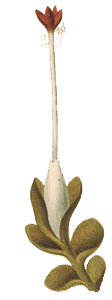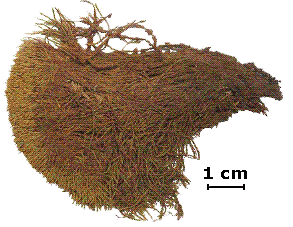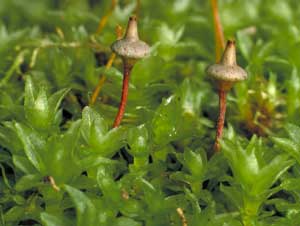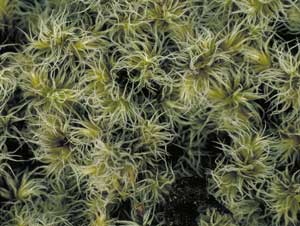
Bryogeography
Tools and hypotheses
In this section we'll look at some hypotheses as to how a few current bryophyte distributions could have arisen. The aim here is to give you some idea of bryogeographical reasoning, with an introduction to some of the tools and methods of bryogeographical analysis. Within this section there won't be any detailed arguments in favour of any particular hypothesis. You will however find links to a few case studies which present some more detailed bryogeographical arguments.
The family Hypopterygiaceae seems to be of Gondwanan origin, even though several species are found in the northern hemisphere. However, It is predominantly a Southern Hemisphere family. Interestingly seven of the eight genera in the family are found in the New Zealand area, suggesting a high degree of evolution and diversification in the " New Zealand" part of Gondwana. There are more details in the HYPOPTERYGIACEAE CASE STUDY.
What about the genus Pleurophascum? On the basis of current evidence this genus is endemic to Australasia. Perhaps it evolved in the Australasian region, long after the break-up of Gondwana. Millions of years ago southern Australia was wetter and more densely vegetated so Pleurophascum could have had a large area in which to evolve and diversify. But here is another hypothesis. Perhaps Pleurophascum is really a very old Gondwanan genus which contained many species, but which was never found across all of Gondwana. Its main centre could have been that part of Gondwana now covered by the Antarctic ice cap and what is now southern Australasia was on the periphery of the original distribution. In such a scenario the three Australasian species would simply be the remnants of a once large and widespread genus.
The genus Tayloria presents a more complicated problem. Certainly, the species Tayloria gunnii looks to be endemic to and could have evolved in Australia – but that's not the case for the genus as a whole. Tayloria gunnii belongs to a group of Tayloria species which are found in either South America or Australasia. It would seem that this group has a Gondwanan origin, with further evolution to the modern species in the separated areas of Australasia and South America. The occurrence of Tayloria lingulata across the temperate and boreal parts of the Northern Hemisphere is not an unusual one. There are many bryophytes with such a Holarctic distribution. Northern Eurasia was united with North America in the ancient super-continent of Laurasia and perhaps some bryophytes date back to those times. Even after the split parts of North America and Eurasia have been relatively close for very long periods, so allowing relatively easy movement of bryophytes between those continents.
Tayloria rudolphiana, with its disjunctive Europe/China distribution, presents more of a puzzle. Here are three hypotheses, by no means the only ones possible. There may have been long-distance wind dispersal from one area to the other. Humans may have inadvertently carried the species from one area to the other. Perhaps the species was once found from Europe to China but has disappeared from virtually all of its former range.
The spores of Tayloria rudolphiana are 9-12 micrometres in diameter and are theoretically capable of wind dispersal over such a distance. At both localities the species grows in alpine areas on branches or trunks of trees. With the mosses raised above the ground it's easier to get the spores higher into the air. However the ability to travel long distances isn't proof of its occurrence. The LONG-DISTANCE DISPERSAL CASE STUDY notes the various questions you'd need to answer before you had convincing evidence of long-distance wind dispersal. On the subject of the second hypothesis we'd need to look at historical records for any human connection between the two areas. Do old church documents show an influx of German missionaries into south-west China? Was there some form of trade between the two areas? What about plant collectors? The 19th century saw the start of great Western interest in the plants of China and many European and American plant collectors travelled through remote areas of China. Did one of these inadvertently transport the moss. What about the third hypothesis? Bryophyte knowledge is fairly poor for much of the area between the European and Chinese locations of Tayloria rudolphiana. Perhaps the species does in fact grow in many areas of, say, Central Asia and the Caucasus and it's just that nobody has ever collected in any of those areas. If Tayloria rudolphiana were to be found in some of those intermediate areas there would be no need to ponder upon some special human connection between two small areas in south-west China and central Europe. We would no longer need to invoke aerial dispersal over more than 6,000 kilometres but the new discoveries would not rule out wind dispersal. Such dispersal may still have occurred, but in a series of shorter steps, rather than in one long step.
There is a vast area between Europe and China and it is unrealistic to expect a bryological expedition to search it all for Tayloria rudolphiana. Does the moss show the same ecological and climatic preferences in both the areas from which it is known? Examples of ecological and climatic factors are substrate preference, the surrounding vegetation, rainfall pattern, temperature ranges and light levels. If the two areas show strong similarities in such factors you might expect to find the species in other areas with similar features. You could attempt to predict where such areas occur, either manually or by using one of the computer software packages designed for the purpose. A prediction is not proof of occurrence, and both manual and computer prediction have their limitations, but it could help target the search. Instead of searching over a million square kilometres of Central Eurasia for Tayloria rudolphiana a prediction program might point to just a few "most likely" search areas.
 Of course even such an expedition would still be expensive. Many of the world's older herbaria have extensive bryophyte collections that have been gathered from all continents of the world and amongst those collections there are specimens from Central Eurasia. The latter half of the 19th century saw many plant collections made between China and Europe - in areas such as Turkey, the Caucasus, Iran and Central Asia. The collectors varied from non-botanists to amateur or professional botanists and many of them collected at least some bryophytes. As an example, the Finnish bryologist VF Brotherus (1849-1929) led an expedition to Central Asia in 1896, traversing an area from the Caspian Sea to the Tyan Shan Mountains on the border of present-day Kazakhstan and China. The accompanying photo (right) shows one of his collections, of a moss in the genus Philonotis, made on 26 July 1896 near Narynkol close to the Kazakhstan-Chinese border (click here to get the full story)
Of course even such an expedition would still be expensive. Many of the world's older herbaria have extensive bryophyte collections that have been gathered from all continents of the world and amongst those collections there are specimens from Central Eurasia. The latter half of the 19th century saw many plant collections made between China and Europe - in areas such as Turkey, the Caucasus, Iran and Central Asia. The collectors varied from non-botanists to amateur or professional botanists and many of them collected at least some bryophytes. As an example, the Finnish bryologist VF Brotherus (1849-1929) led an expedition to Central Asia in 1896, traversing an area from the Caspian Sea to the Tyan Shan Mountains on the border of present-day Kazakhstan and China. The accompanying photo (right) shows one of his collections, of a moss in the genus Philonotis, made on 26 July 1896 near Narynkol close to the Kazakhstan-Chinese border (click here to get the full story) ![]() .
.
The first decades of the 20 th century saw further botanical collecting in the same parts of Eurasia so a search through some of the older herbaria might yield more specimens of Tayloria rudolphiana, perhaps mis-identified or still sitting amongst collections that have never been studied. Such a search would still be painstaking work, with no guarantee of success but it is one of the possible avenues to follow. Herbarium collections from the 1800s and 1900s would be useful for more than just a study of Tayloria rudolphiana. Those collections may be the only representatives of some species from areas now dramatically changed by expanding urbanisation or forest clearing. Herbaria also hold collections from areas where it would now be impossible to collect because of political barriers or social unrest. Below is a herbarium packet that contains a specimen of the moss Leptodictyon riparium, collected in 1933 from an area that few bryologists would be keen to visit today. If you were to rely just on what you can find today, you would almost certainly be missing crucial evidence of past distributions.
While on the subject of old collections, even older than herbarium specimens are the fossils. They give evidence as to where and when various bryophytes flourished eons ago. While there are many bryophyte fossils, the bryophyte fossil record is rather poor when compared to that of the flowering plants. Bryophytes probably fossilize poorly in sedimentary layers because of their generally flimsy nature. That fact would tend to bias the sedimentary fossils towards the more robust species. There are also problems in recognizing and interpreting bryophyte fossils and it is possible that bryophyte fossils are damaged by the techniques used to extract vascular plant fossils. Amber provides another means of preservation, one that is particularly favourable to softer tissues. Amber starts as sap flow from a wound in a trunk or branch of a tree. Such oozing sap has trapped bryophytes, insects, leaves, fruits and various other objects. Over time the sap hardens and anything trapped inside is saved for posterity. Bryophytes that grow on trees clearly would be the ones most likely to be found in amber. While the fossil evidence may be biased one way or the other, it is evidence nevertheless and, used carefully, can help in bryogeographical analysis![]() .
.
Since the late 1900s DNA and RNA analyses have become widespread in biological investigations. Most people would be aware of such molecular analyses in criminal forensic investigations and for determining familial relationships. Keeping to a human example for the moment, siblings are more closely related than are cousins. Siblings have parents in common. Cousins do not have parents in common but do have grandparents in common. Siblings have more DNA in common than have cousins. So, the greater the match in DNA the closer the relationship and the closer the relationship the closer to the present were the most recent of the common ancestors.
Think of a bryophyte colony, such as that of the moss in the accompanying photograph. There are numerous separate plants and, with the help of a microscope, it's easy to see that they all belong to the same species. However, that tells you nothing about the genetic relationships within the colony. Are the plants genetically identical, suggesting that they all grew from vegetative propagules produced by just one parent plant? Or is there considerable genetic variation, indicating multiple parents and a very mixed ancestry for this colony? Molecular analysis can give you that sort of information and you could apply such analysis to the plants in one colony or to plants in widely separated colonies – such as Chinese and European representatives of Tayloria rudolphiana. If such an analysis were done, it would provide another strand of evidence to help unravel the mystery behind the current distribution of Tayloria rudolphiana.
Molecular analyses have been used also to determine the closeness of relationships between different species or different genera of bryophytes. In this way it is possible to build up family trees of bryophytes and see how different lines of descent have evolved. By looking at the amount of difference in the DNA between two current species and by combining that information with the rates at which DNA mutates, you can get an idea of how long ago their most recent common ancestor lived. This can help choose between bryogeographic possibilities. To give a very simplistic scenario, suppose that DNA analysis tells you that the most recent common ancestor of an Australian and a South American species dates to about 90 million years ago. Then that common ancestor could have lived in Gondwana and given rise to two Gondwanan species which evolved in separate areas of Gondwana and eventually produced the current Australian and South American species. If the date were 9, rather than 90, million years the above conclusion is impossible since the most recent common ancestor would post-date the break-up of Gondwana. While such molecular clocks are helpful when used carefully, they have their problems, which are beyond the scope of this website. You can easily find out more via your favourite search engine.
![An Australian Government Initiative [logo]](/images/austgovt_brown_90px.gif)



